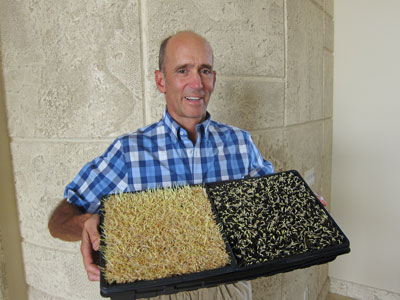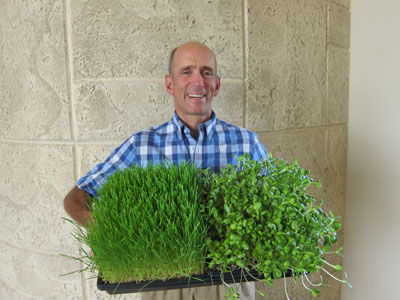[embed]https://www.bitchute.com/video/LKlHY20ea184/[/embed]
STORY AT-A-GLANCE
- Severe food shortages are coming and appear to be inevitable, more or less worldwide; whatever food is available will continue to go up in price
- Growing your own food is something I encourage virtually everyone to take part in, even if you have limited space
- One food that requires very minimal space, yet packs a powerful nutritional punch, is sprouts
- Sprouts offer unique benefits due to the fact that they’re in their initial and early phase of growth
- Compared to mature plants, sprouts contain more concentrated amounts of nutrients, antioxidants and other health-promoting phytochemicals, and fewer antinutrients
- In about a week, you can have fresh, nutritious food that can be harvested daily as needed
As a cabal of technocratic elite battle for control of the world’s resources, global systems of food and energy production are being increasingly targeted and dismantled. This is all part of The Great Reset, a decades-old plan from the World Economic Forum’s (WEF) to seize control of wealth and resources.
It’s becoming increasingly clear that severe food shortages are coming and appear to be inevitable, more or less worldwide. Further, whatever food is available will continue to go up in price. That’s why now is a crucial time to learn new methods of self-sufficiency and resiliency. I describe them as “new” methods, but many of them are actually not new at all and could more aptly be described as “old-fashioned.”
| Antioxidant | Antidiabetic | Cytotoxic |
| Hypocholesterolemic | Antiobesity | Antiviral |
| Antiatherosclerosis | Anticancer | Anti-inflammatory |
| Antimicrobial | Antistress |
Planting and Harvesting Sprouts at Home
I used to grow sprouts in Ball jars more than 30 years ago, but growing them in soil is far easier and produces more nutritious and abundant food. It is also less time-consuming and takes up less space. I then started the process up again nearly 10 years ago.However, as you may discern from the photos below, it has been more than five years since I gave up growing sunflower sprouts. This is primarily because I learned of the massive importance of excess omega-6 fat in the form of linoleic acid (LA) in the food supply.
Excess is the key here and that is what I was doing. I was growing the sprouts and consuming a large bowl of them nearly every day. Little did I know that this was radically increasing my LA intake to unhealthy levels.
The key is the dose. High-quality, unadultered olive oil can be healthy in the context of limiting it to about 1 tablespoon a day, while having a few ounces a day would rapidly put you into excess LA territory.
 About to plant wheat grass and sunflower seeds — two days after soaking About to plant wheat grass and sunflower seeds — two days after soaking |  Wheat grass and sunflower seeds — 3.5 days post germination Wheat grass and sunflower seeds — 3.5 days post germination |
 Sunflower seeds and pea sprouts — three days until ready for harvest Sunflower seeds and pea sprouts — three days until ready for harvest |  Sunflower seed sprouts and wheat grass — ready to harvest Sunflower seed sprouts and wheat grass — ready to harvest |
| First, soak the seeds in clean water for eight hours |
| Empty the soaking water into a watering can or other container to use for watering other plants |
| Rinse the seeds and leave them unsoaked for 24 hours or until sprouts germinate |
| Next, fill a tray halfway with soil |
| Spread the seeds evenly over the soil |
| Water until the soil is moist but not dripping |
| Cover the soil with ceramic tile and 5- to 10-pound weights |
| Remove the tiles to water every 24 hours for two to four days; replace the tiles and weights between waterings |
| Once sprouts begin to lift the tiles, remove them |
| Place the tray in a sunny area |
| Harvest the sprouts after two to three days by clipping them at the base with scissors |
Commercially grown sprouts are also one of the most commonly contaminated foods — another reason why growing your own makes sense. One pound of seeds can produce over 10 pounds of sprouts. Sunflower sprouts give you the most volume for your effort and, in my opinion, have the best taste.
Additional Tips for Surviving the Food Crisis
Depending on where you live, you’re now starting to see food shortages to a greater or lesser degree. But regardless of how things appear right now, expect changes, potentially drastic ones, over the coming months and into 2023, because that’s when the diminished yields from the current growing season will become apparent.By getting prepared now, you’ll be able to weather the storm and feel more at ease, knowing your most basic needs will be met. Growing as much fresh food as you can is one important strategy, but you’ll need to ensure you have plenty of seeds on hand. At bare minimum, stock up on sprouting seeds, but if you have the space, consider starting a garden or planting a small orchard.
If local regulations allow, you can add chickens for a steady supply of eggs. (Just remember that they, too, may need additional feed.) You can also join a local food co-op, and buy shelf-stable and nonperishable foods in bulk. Freeze-dried foods can have a shelf life of 25 years or more.
Canned foods and dry staples such as rice and beans can also stay viable long past their expiration date under the right conditions. Other good options include canned salmon, canned cod livers, sardines in water (avoid ones preserved in vegetable oil), nuts, powdered milk and whey and other nutritional powders you can mix with water.
Ideally, you'll want to store food in a cool, dark place with low humidity. Bulk packs of rice and beans are best stored in a sealed food-grade bucket with some oxygen absorbers. Vacuum sealing food can also extend shelf life, as can basic food storage skills such as canning and pickling.
As I mentioned earlier, what’s old is new again; embracing the methods that your grandparents or great grandparents used to store their food out of necessity will allow you to be self-sufficient in the event of an upcoming food crisis. If and when that occurs, you’ll be glad for the sprouts growing on your windowsill.
Sources and References
- 1, 2 Substack, Dr. Mercola’s Censored Library March 21, 2022
- 3, 4, 11 PNAS USA September 16, 1997; 94(19): 10367-10372
- 5 J Agric Food Chem. 2012 Nov 7;60(44):11050-5. doi: 10.1021/jf304443u. Epub 2012 Oct 30
- 6 Plants (Basel). 2022 Feb; 11(4): 571, Section 2.1
- 7 Chemistry Central Journal 2014; 8: 4
- 8 Plants (Basel). 2022 Feb; 11(4): 571
- 9 Nutrients. 2021 Aug; 13(8): 2882, Section 3
- 10, 12 Nutrients. 2021 Aug; 13(8): 2882, Section 4
- 13 Journal of Agricultural Science; Vol. 5, No. 4; 2013






